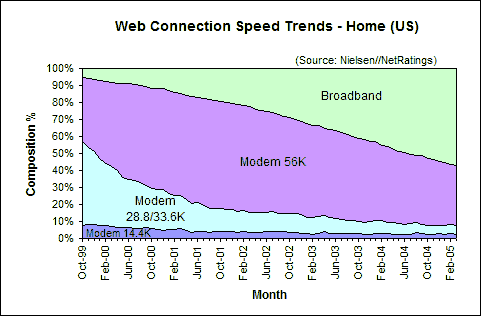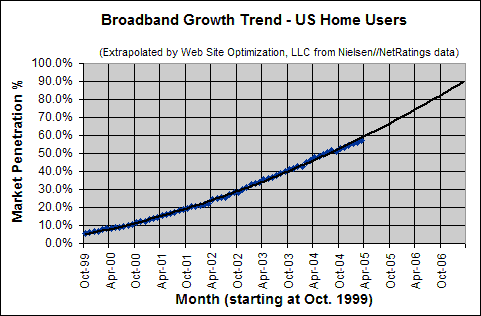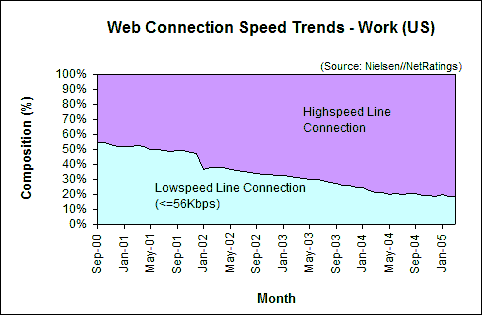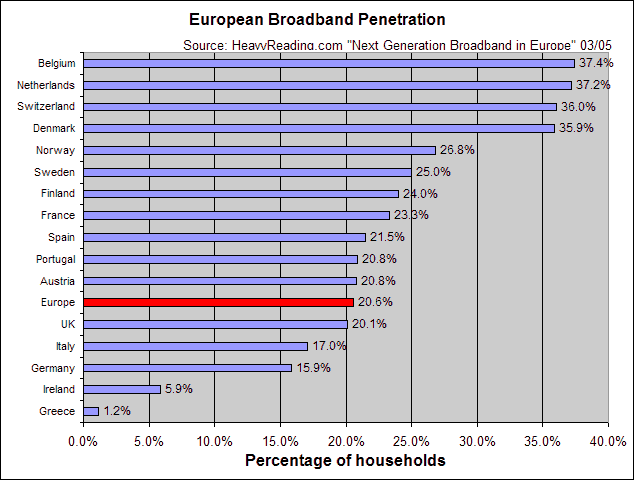Belgium, the Netherlands, and Switzerland lead European countries in overall broadband penetration, according to a survey by HeavyReading.com in March 2005. In March, broadband penetration among active Internet users in the U.S. grew by 0.75 percentage points to 57.04%. Narrowband penetration in US homes fell to 42.96% in March 2005.
The charts below, derived from Nielsen//NetRatings data, show trends in connection speeds to the Internet for United States users.*
Home Connectivity in the US
Most active Internet users connect from home with broadband connections. Among narrowband users, 35.42% use 56Kbps modems, 4.89% use 28/33.3Kbps, and 2.64% use 14.4Kbps modems. In total, 42.96% of home users in the US connect to the Internet at 56Kbps or less (see Figure 1).
Web Connection Speed Trends – Home Users (US)
Figure 1: Web Connection Speed Trends – Home Users (US)
Source: Nielsen//NetRatings
Broadband Growth in the US
Broadband penetration in the US grew by 0.75 points to 57.04% in March, up from 56.29% in February. This increase is below the average increase in broadband of 1.04 points per month over the previous twelve months. At the current growth rate, broadband share in the US should exceed 70% by January of 2006 (see Figure 2). As we reported last issue, broadband penetration growth appears to be tapering off in the US, in a pattern similar to Canada and Korea.
Broadband Connection Speed Trend – Home Users (US)
Figure 2: Broadband Connection Speed Trend – Home Users (US)
Extrapolated from Nielsen//NetRatings data
Work Connectivity
Most workers in the US enjoy high-speed connections to the Internet. Most use a high-speed line such as a T1 connection, and share bandwidth between computers connected to an Ethernet network. The speed of each connection decreases as more employees hook up to the LAN. As of March of 2005, of those connected to the Internet, 81.53% of US users at work enjoy a high-speed connection, virtually unchanged from the 81.56% share in February. At work, 18.47% connect at 56Kbps or less (see Figure 3).
Web Connection Speed Trends – Work Users (US)
Figure 3: Web Connection Speed Trends – Work Users (US)
Source: Nielsen//NetRatings
Belgium Leads European Countries in Broadband Penetration
Belgium, the Netherlands, and Switzerland lead European countries in overall broadband penetration, according to a survey by HeavyReading.com in March 2005. Belgium boasts 37.4% broadband penetration among all households, with the Netherlands close behind at 37.2% penetration, and Switzerland at 36% penetration. Greece, Ireland, and Germany trail all European countries in broadband penetration. The average broadband penetration among all households in Europe is 20.6%. Note that if these figures follow the same pattern as in the U.S., broadband penetration among active users in Europe would approach 65 to 70% in the top three countries. For comparison, the U.S. is at about 30% overall penetration now, according to Leichtman Research, while broadband penetration among active internet users is 57%, so the ratio is about 2:1 for active vs. households.
European Broadband Penetration Rates – All Households
Figure 4: European Broadband Penetration Rates – Percentage of Households
Source: HeavyReading.com, 03/05
Further Reading
- HeavyReading.com
- Provided the European broadband penetration data, see also LightReading.com.
- Nielsen//NetRatings
- Provides the US broadband data (percentage of active Internet users) for the Bandwidth Report.
- Rich Media Ads Proliferating
- In a related story, by 2009 rich media ad units will account for over half of all online display ads by spending, according to Jupiter Research.
*Note that Nielsen//NetRatings reports the percentage of active Internet users that use broadband from home, not broadband households. NetRatings uses a panel of 40,000 to 50,000 people with software meters installed on their computers. These meters detect connection speeds. Each month they do an enumeration study to call a number of people to calibrate the panel by adjusting weightings to match the population at large.
The Bandwidth Report is featured monthly on URLwire – news of useful and unique web content since 1994.




